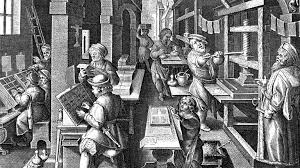Firstly, the pioneers of the Printing Press were Johannes Gutenberg, and those before him who invented the idea of printing. Prior to Gutenberg’s invention there were already moveable types of printing created in Korea as well as woodblock printing in China. However, Gutenberg is attributed as the mind behind this genius invention due to his specific form of the printing press, which involved a screw-type wine press that squeezed down inked metal pieces evenly. Not only did his invention improve upon the world of printing, but it allowed for literature to now be easily and inexpensively printed, leading to more accessible written knowledge.

In addition, the early majority who followed were the middle class as a whole. As previously mentioned, prior to the printing press’s invention literature, especially books, were very expensive and hard to come by. This was due to the fact that each book would have to be copied page by page, by hand. Therefore, the middle class was not able to spend their money on such a “useless” indulgence. However, the printing press made it affordable and so a lot of people from the middle class were now able to own their own books. This led to an increase in literacy and education as a whole, causing a much more intelligent society. Also, this helped in the spread of ideas as more people were informed and able to join in on conversations, as well as share and send printed copies of works to one another therefore spreading ideas and topics across countries and cultures.
Moreover, following right behind the majority in Europe, the late majority of the printing press was the West. The exploration of the West such as the Americas was all the rage during the 15th and 16th centuries. The Europeans brought much over to the Americas including horses, crops, disease, and inventions such as the printing press. It was used by traders, colonists, and missionaries who traveled across the sea to the Americas. This made a lot of sense as the Americas were mostly just an extension of Europe, which at the time was where the printing press was most popularized.
Finally, there are the laggards, which is the group who lags behind the general population in adopting innovative products and new ideas. In the case of the printing press, the Ottoman empire is certainly a part of the laggards. The Ottoman Empire, also known as the Turkish Empire, put off using the printing press for 290 years and more. The scribes, calligraphers, and professional manuscript scribes were adamant about not participating in the printing press wave. This grudge was due to the fact that they made their living off of copying texts and were quite wealthy from it. Therefore, they pushed off bringing the printing press to the Ottoman Empire in order to stay employed. At one point, it was actually illegal to use the printing press in the Ottoman Empire and potentially could lead to a penalty of death. Additionally, it not only took 290 years to approve the idea of the printing press but then another 100 years in order to fully build the printing house and machinery. Therefore, the Ottoman Empire was q
uite behind on the trend and implementation of the printing press.
Overall, the printing press was such a significant and impactful invention that was adopted for several different purposes by many different groups. It was used to help promote education and literacy, to spread religious ideas and propaganda, as well as a way to spread new ideas such as during the Renaissance. Each group that utilized the printing press had their own motives which pushed them to get involved at the point that they did, as people only sought after it after realizing how much easier it made their work. However, as mentioned it made publishing literary works much quicker and cheaper. Therefore, it took away the need for scribes as the machine was able to print at a much faster rate, and needed only a few workers to operate it. Regardless of the loss of jobs though, it was outweighed by the new access to literature that was made possible to people of all social statuses, religions, and languages. In all, the adaptation of the printing press was positive for most aspects of society and went on to influence and inspire how communication and print happens even today.






No comments:
Post a Comment